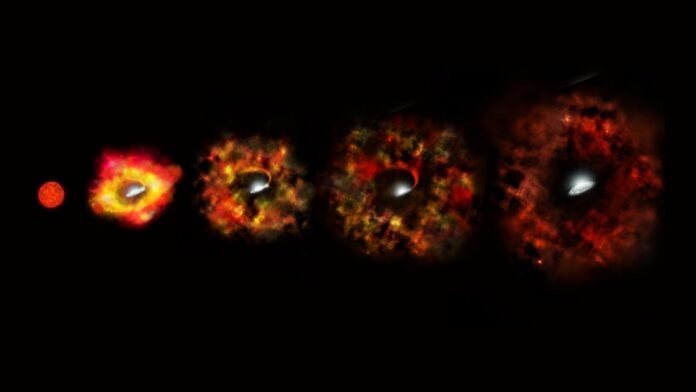Massive stars about eight times more massive than the Sun explode as supernovae at the end of their lives. The explosions, which leave behind a black hole or a neutron star, are so energetic they can outshine their host galaxies for months. However, astronomers appear to have spotted a massive star that skipped the explosion and turned directly into a black hole.
Stars are balancing acts between the outward force of fusion and the inward force of their own gravity. When a massive star enters its last evolutionary stages, it begins to run out of hydrogen, and its fusion weakens. The outward force from its fusion can no longer counteract the star’s powerful gravity, and the star collapses in on itself. The result is a supernova explosion, a calamitous event that destroys the star and leaves behind a black hole or a neutron star.
However, it appears that sometimes these stars fail to explode as supernovae and instead turn directly into black holes.
New research shows how one massive, hydrogen-depleted supergiant star in the Andromeda galaxy (M31) failed to detonate as a supernova. The research is “The disappearance of a massive star marking the birth of a black hole in M31.” The lead author is Kishalay De, a postdoctoral scholar at the Kavli Institute for Astrophysics and Space Research at MIT.
These types of supernovae are called core-collapse supernovae, also known as Type II. They’re relatively rare, with one occurring about every one hundred years in the Milky Way. Scientists are interested in supernovae because they are responsible for creating many of the heavy elements, and their shock waves can trigger star formation. They also create cosmic rays that can reach Earth.
This new research shows that we may not understand supernovae as well as we thought.

The star in question is named M31-2014-DS1. Astronomers noticed it brightening in mid-infrared (MIR) in 2014. For one thousand days, its luminosity was constant. Then, for another thousand days between 2016 and 2019, it faded dramatically. It’s a variable star, but that can’t explain these fluctuations. In 2023, it was undetected in deep optical and near-IR (NIR) imaging observations.
The researchers say that the star was born with an initial mass of about 20 stellar masses and reached its terminal nuclear-burning phase with about 6.7 stellar masses. Their observations suggest that the star is surrounded by a recently ejected dust shell, in accordance with a supernova explosion, but there’s no evidence of an optical outburst.
“The dramatic and sustained fading of M31-2014-DS1 is exceptional in the landscape of variability in massive, evolved stars,” the authors write. “The sudden decline of luminosity in M31-2014-DS1 points to the cessation of nuclear burning together with a subsequent shock that fails to overcome the infalling material.” A supernova explosion is so powerful that it completely overcomes infalling material.
“Lacking any evidence for a luminous outburst at such proximity, the observations of M31-2014-DS1 bespeak signatures of a ‘failed’ SN that leads to the collapse of the stellar core,” the authors explain.
What could make a star fail to explode as a supernova, even if it’s the right mass to explode?
Supernovae are complex events. The density inside a collapsing core is so extreme that electrons are forced to combine with protons, creating both neutrons and neutrinos. This process is called neutronization, and it creates a powerful burst of neutrinos that carries about 10% of the star’s rest mass energy. The outburst is called a neutrino shock.
Neutrinos get their name from the fact that they’re electrically neutral and seldom interact with regular matter. Every second, about 400 billion neutrinos from our Sun pass right through every person on Earth. But in a dense stellar core, the neutrino density is so extreme that some of them deposit their energy into the surrounding stellar material. This heats the material, which generates a shock wave.
The neutrino shock always stalls, but sometimes it revives. When it revives, it drives an explosion and expels the outer layer of the supernova. If it’s not revived, the shock wave fails, and the star collapses and forms a black hole.

In M31-2014-DS1, the neutrino shock was not revived. The researchers were able to constrain the amount of material ejected by the star, and it was far below what a supernovae would eject. “These constraints imply that the majority of stellar material (?5 solar masses) collapsed into the core, exceeding the maximum mass of a neutron star (NS) and forming a BH,” they conclude. About 98% of the star’s mass collapsed and created a black hole with about 6.5 solar masses.
M31-2014-DS1 isn’t the only failed supernova, or candidate failed supernova, that astronomers have found. They’re difficult to spot because they’re characterized by what doesn’t happen rather than what does. A supernova is hard to miss because it’s so bright and appears in the sky suddenly. Ancient astronomers recorded several of them.
In 2009, astronomers discovered the only other confirmed failed supernova. It was a supergiant red star in NGC 6946, the “Fireworks Galaxy.” It’s named N6946-BH1 and has about 25 solar masses. After disappearing from view, it left only a faint infrared glow. In 2009, its luminosity increased to a million solar luminosities, but by 2015, it had disappeared in optical light.
A survey with the Large Binocular Telescope monitored 27 nearby galaxies, looking for disappearing massive stars. The results suggest that between 20% and 30% of massive stars can end their lives as failed supernovae. However, M31-2014-DS1 and N6946-BH1 are the only confirmed observations.


